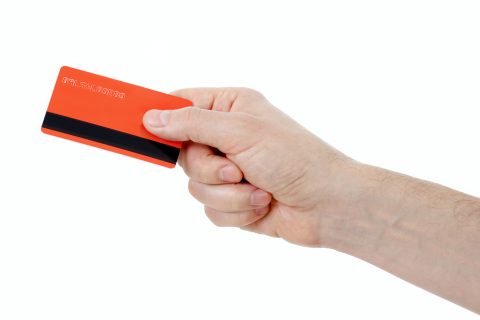EMV is a technical standard designed to limit in-person card fraud. It stands for Europay, Mastercard and Visa — the companies that created it. EMV has been adopted by major payment networks. Rather than using the traditional magnetic strip, an EMV credit card uses a small computer chip to store information and make transactions more secure. While accepting EMV cards isn’t a requirement, businesses that choose not to accept them face additional liability for fraudulent charges. Here’s what to know.
How does EMV technology work?
In the past decade, EMV chips have been slowly replacing magstripes — the magnetic strips commonly found on the back of credit cards. A magstripe stores data unique to a given credit card, such as the credit card number, and can only communicate in one direction by sending its data to a point-of-sale terminal. It cannot react to a POS terminal’s attempts to confirm that a credit card is not fraudulent.
How magstripes work
Magstripe card. (Getty Images photo)
Magstripes use static data, which means they don’t encode your information when sending it through a credit card terminal. As a result, traditional credit cards have no way of protecting the data once a terminal has accessed it.
Think of it this way: Swiping a magstripe is like writing down your credit card information and sticking it to the back of your credit card. Anyone who can read the piece of paper can use the information to make a copy of your credit card and charge purchases to your account.
How EMV chips work

EMV-chipped card. (Getty Images photo)
EMV chips offer a more secure method for storing and transmitting credit card information. While magstripes send a credit card’s number directly to a terminal, EMV chips use encryption and tokenization to encode the data. This method keeps the credit card information confidential throughout the transaction.
So instead of having your credit card information written clearly on a piece of paper, using EMV chips is like writing the information in code that can be easily read by the payment companies involved in the transaction, but not by others.
How do EMV chips protect against fraud?
EMV chips protect against card fraud by verifying that a card is authentic.
In addition to encoding credit card information, EMV chips also change the code every time data is transmitted to the payment companies. Cards that have a magstripe only are easily skimmed and copied, but chip cards are difficult to replicate, and transactions from an inauthentic card are easily flagged.
Although EMV chips make in-person transactions more secure, they don’t guard against fraudulent online transactions where the credit card isn’t inserted or tapped at a POS terminal.
The EMV liability shift
Payment networks wanted to save money by encouraging merchants to adopt EMV technology that reduces potential fraud. They couldn’t force merchants to make the switch, but they were able to give businesses an ultimatum: Accept EMV credit cards or take on the responsibility for certain fraudulent charges.
This change in liability, known as the EMV liability shift, went into effect on Oct. 1, 2015, for most retail businesses. Locations that sell fuel, such as convenience stores, were granted an extension: They did not have to implement EMV technology to avoid liability until April 17, 2021.
Upgrading to EMV credit card readers is not a requirement by law, and businesses can continue to operate without accepting dipped or tapped cards. But doing so comes with increased liability that could cost them if they process a fraudulent charge.
What is your business liable for?
The shift does not affect all transactions, but some transactions will carry more liability for businesses without EMV credit card readers.
Businesses have increased liability for:
-
An EMV credit card that is keyed in or swiped with a POS app instead of inserted or tapped.
Businesses’ liability has not changed for:
-
Online transactions, such as purchases through a website, with a virtual terminal or in response to a digital invoice.
-
An in-person transaction made with a non-EMV credit card (a magstripe card).
Benefits of accepting EMV chip cards
Accepting credit cards with EMV chips comes with a few advantages that could save you money and bring in more customers. EMV chip cards:
-
Reduce the potential for fraud. Credit cards with EMV chips are more difficult to copy and pose a larger obstacle for hackers.
-
Minimize liability. If in-person card fraud still happens while using the EMV features of a card reader, you won’t be liable.
-
Are becoming more common. Accepting EMV chip cards allows you to work with more customers who prefer to pay this way.
How to accept EMV chip cards
All major POS providers offer EMV chip-enabled credit card readers, and some offer options that combine technology to allow businesses to accept magstripe cards as well. Which type of model works best for your business will depend on how you expect your customers to pay for in-person purchases.
EMV chip card reader recommendations
SumUp
The SumUp Plus card reader is a handheld device that accepts every type of credit card: EMV chips and magstripes, as well as contactless methods such as Apple Pay and Google Pay. It connects to your smart device using Bluetooth and has a screen to display transaction details to the customer. It’s available for $19 and comes with the free SumUp app and dashboard.
Clover
Clover Go is a compact option that lets you process every type of credit card payment: EMV chip cards, magstripe cards and digital wallets, including Apple Pay, Google Pay and Samsung Pay. It has Bluetooth functionality, but no screen to share checkout details with customers. It’s priced at $99 and offers reporting as a free POS feature.
Square
The Square reader for contactless and chip cards is sleek and simple. It accepts contactless and EMV chip cards, as well as Apple Pay and Google Pay. However, you can’t use it to swipe magstripe cards. The Square reader uses Bluetooth to connect to your smart device, but it doesn’t have a screen of its own. You can get the reader for $49 and take advantage of Square’s free POS features.
This post was originally published on Nerd Wallet







